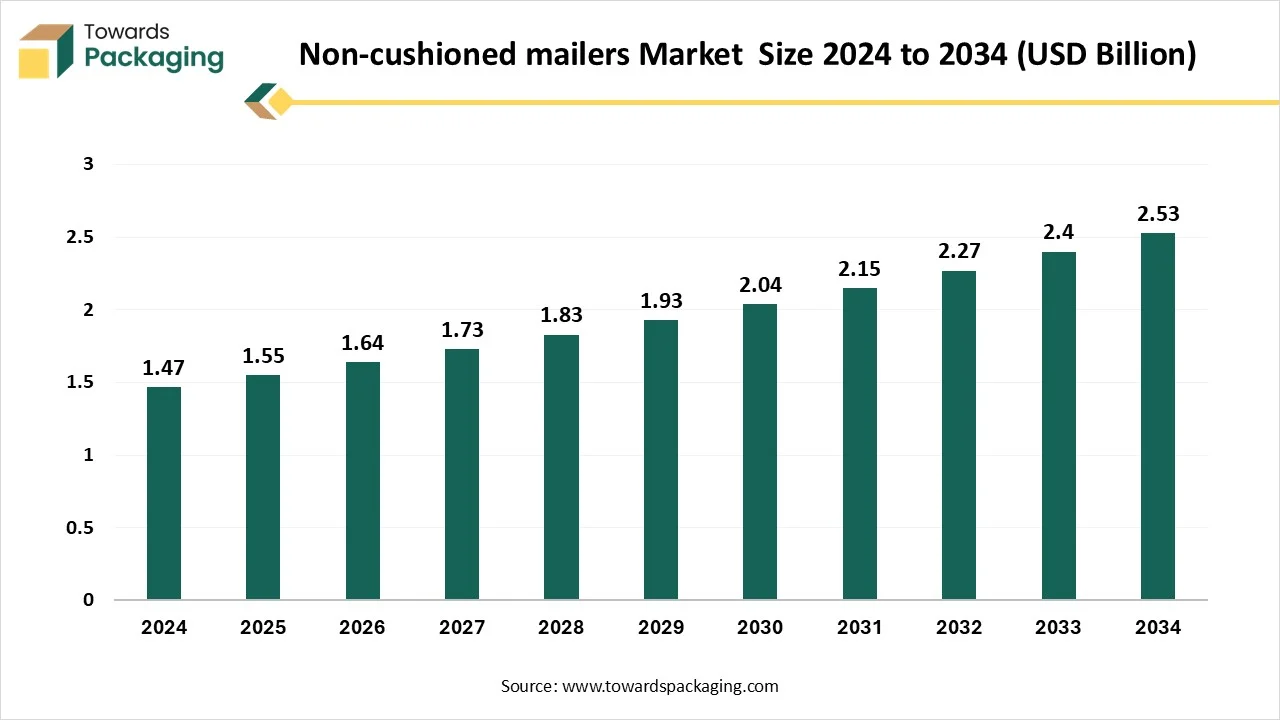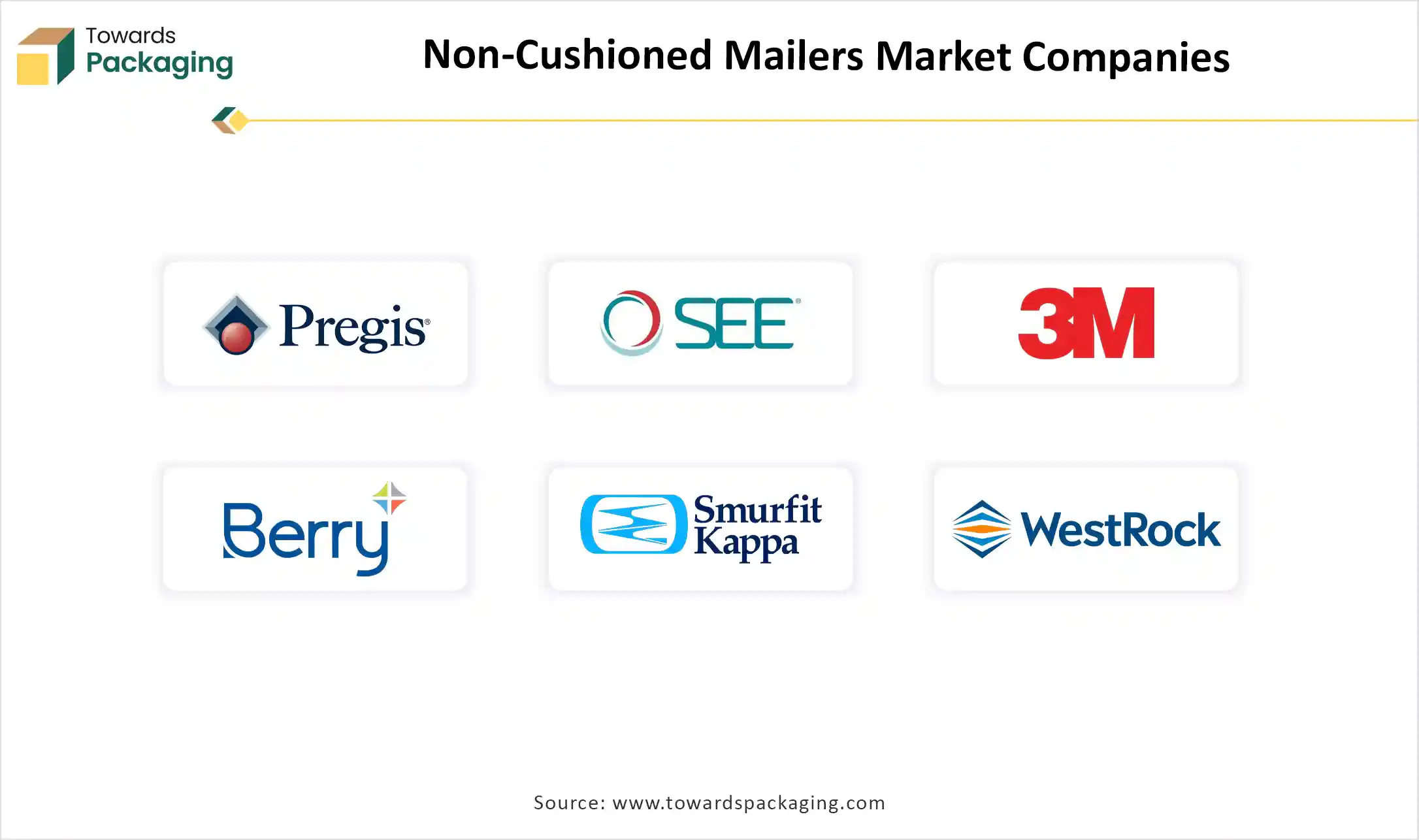The non-cushioned mailers market provides a detailed overview of global demand trends, covering complete statistical insights including the 2024 market size of USD 1.47 billion and the projected USD 2.53 billion valuation by 2034. The study highlights key trends, segment data by material type and end use, and regional performance across North America, Europe, Asia Pacific, Latin America, and MEA. It also includes an in-depth analysis of major companies, trade flows, manufacturer and supplier information, and a full value chain assessment from raw materials to distribution.

In the packaging industry, non-cushioned mailers are usually made of materials like paper, paperboard, or plastic film, offering a lightweight and economical shipping option for goods that do not require additional padding or protection during transit. Non-cushioned mailers are lightweight, cost-effective, versatile, and come in various options, ranging from white poly to reinforced kraft. They are most commonly utilised for clothing, soft toys, documents, linens, pet supplies, or lightweight products.
| Metric | Details |
| Market Size in 2024 | USD 1.47 Billion |
| Projected Market Size in 2034 | USD 2.53 Billion |
| CAGR (2025 - 2034) | 5.64% |
| Leading Region | Asia Pacific |
| Market Segmentation | By Material Type, By End Use and By Region |
| Top Key Players | Pregis, Sealed Air Corporation, 3M Company, Berry Global Inc., Smurfit Kappa Group, WestRock Company. |
As technology continues to evolve, Artificial intelligence integration is significantly revolutionizing the entire packaging landscape. AI-powered systems assist in streamlining processes to maximize resource efficiency and minimize waste throughout the entire packaging lifecycle. Machine Learning (ML) can effectively detect flaws in packaging materials, minimize material waste, and eliminate the chances of errors. AI can also improve the efficiency of inspection processes in the market, ensuring high-quality, lightweight, and cost-effective products. AI-powered solutions provide predictive maintenance, identifying potential risk, which further assists in reducing maintenance costs and improving equipment uptime.
Expansion of Transportation Industry
The rising demand for non-cushioned mailers in the logistics and transportation industry is expected to boost the growth of the market. In the logistics and transportation industry, non-cushioned mailers is widely used for product protection, reduced product damage, and improved handling efficiencies. Non-cushioned mailers assists in protecting the products from various environmental factors, such as dust, dirt, water, moisture, and other contaminants. UVI stretch film rolls can even protect the load from UV rays. Non-cushioned mailers maximizes the warehouse space while storing the products.
Environmental and Regulatory Pressures
The rising environmental concerns related to plastic waste is anticipated to hinder the market's growth. The increasing regulatory pressures on packaging industries are pushing them to adopt sustainable alternatives. In addition, the fluctuation in the price of raw materials polymer-based materials which are widely in the production of stretch films, can adversely impact the profitability of manufacturers. Such factor may hinder the growth of the global non-cushioned mailers market during the forecast period.
Sustainable Packaging Solutions
The rising focus on sustainable and eco-friendly packaging solutions is projected to offer lucrative growth opportunities to the growth of the non-cushioned mailers market in the coming years. Sustainable stretch wraps offer an eco-friendly alternative to traditional plastic stretch films and are specifically designed to be recycled and reused. It assists businesses in reducing their carbon footprint and becoming more environmentally conscious. Moreover, the rising environmental concern has led the sustainable stretch wrap to gain immense popularity, as well as encouraged businesses to invest in eco-friendly packaging solutions such as biodegradable films, recycled stretch wrap, and others. Thus, driving the expansion of the market during the forecast period.
The polyethylene segment held a dominant presence in the non-cushioned mailers market in 2024, owing to its cost-effectiveness, affordability, and versatility. Polyethylene (PE) offers high strength-to-weight ratios, minimizing shipping costs and making handling easier. Polyethylene (PE) stretch wrap can tightly cover the goods, which protects the product and reduces product damage during storage and transit. Polyethylene (PE) stretch wrap can be waterproof and dustproof with high transparency. On the other hand, the Polyvinyl Chloride (PVC) segment is expected to grow at a significant rate. The growth of the segment is attributed to the rapid expansion of the food industry, owing to its high oxygen transmission rate.
The shipping & logistics industry segment accounted for a significant share of the non-cushioned mailers market in 2024. Stretch wrap is a versatile material used to secure and protect goods as well as keep the load stable during transit and storage. To ensure that the goods arrive safely, stretch wrapping films offer various features to the shipping & logistics Industry, such as multi-directional stretching, load adaptability, and UV resistance. Stretch film plays a crucial role in the shipping and logistics industry. It offers protection, durability, affordability, and versatility, which makes it ideal for businesses of all sizes.
Asia Pacific held the dominant share of the non-cushioned mailers market in 2024. Asia Pacific, especially India and China., have a well-established packaging sector supporting food & beverage, healthcare, and consumer goods industries, all are major users of non-cushioned mailers. The region's high per capita income drives demand for packaged products, especially in e-commerce, retail, and FMCG sectors.
American and European established manufacturers are investing heavily in AI-driven automation in stretch wrapper systems in Asian countries. For instance, In September 2024, Combi Packaging Systems announced the launch of BeeWrap+ Robotic Stretch-Wrapping Technology.
The region’s strong focus on sustainable packaging practices and strict environmental regulations has significantly increased the adoption of sustainable stretch wrap films. Moreover, the rapid growth of e-commerce and the surge in global trade necessitate robust and reliable packaging solutions, contributing to the overall market expansion in the region.
The Europe region is expected to grow at a notable rate in the foreseeable future. The growth of the region is mainly attributed to the growing demand for eco-friendly and biodegradable stretch films, rising integration of automation in packaging processes, and increasing emphasis on improving recyclability. The key players operating in the Europe region have a strong focus on high-performance and sustainable packaging solutions.
Advantage StretchWrap has 62% lower greenhouse gas (GHG) emissions when compared to virgin plastic stretch film, and 49% lower GHG emissions when compared to plastic film made with 50% recycled content.
European countries such as the Netherlands, Spain, France, Germany, and the UK are leading with robust recycling measures and extended producer responsibilities (EPRs). Policies like the European Union’s Circular Economy Action Plan significantly reduce plastic and encourage companies to invest more in sustainable packaging solutions.

By Material Type
By End Use
By Region
December 2025
November 2025
November 2025
October 2025